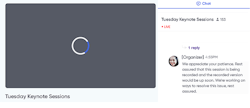Electronic designers and developers depend heavily on the internet these days. It’s great when it works, but not so much when it doesn’t cooperate. Unless your internet service provider (ISP) goes down, you tend to have a degraded experience if a web-based service hits the skids.
That’s what happened today when AWS encountered unspecified problems. I noticed a general slowness in all our tools and websites I was working on. The impact came home when the webinar I was watching decided to give everyone the circle of death (see figure). This was fixed after an hour or so, but I will have to go back and watch the recording when it’s posted since it was a “live” event. It was actually a hybrid in-person, web event that’s likely to become the norm.
AWS is one of a few bit cloud service providers. Their whole infrastructure wasn’t impacted, but it was enough to affect major sites. Though this type of outage isn’t unusual and other major providers have had problems, the problems vary. Likewise, how quickly they’re fixed varies as well.
Putting the Hammer on Tools
The reason I bring this up in our venue is that we were impacted, too, but more due to the tools we use for managing our website as well as our collaboration tools. On the plus side, the tools slowed down today, but the integrity was fine. The website had some issues due more to where images where stored. This highlights the interdependence of tools and services that cloud-based solutions tend to require. We use another service for hosting videos. Cloud problems can affect our sites in different ways depending on what’s working and what’s not.
This isn’t an outlier these days. We embed YouTube videos, too, and if YouTube isn’t working, those videos don’t play.
A Cloudy Cloud
The impact of cloud-based problems becomes more important when they impact your workflow. For example, if we can’t get our newsletters out, then our advertisers don’t pay us. This financial impact can be even more serious for companies using cloud-based services to design and manage chips, IoT devices, or any other products or services tied to the cloud.
It’s great to use a cloud-based simulation like NVIDIA’s Isaac or the various artificial-intelligence/machine-learning (AI/ML) training solutions because the cloud can be used to bring lots of computing and storage power to bear. Again, when it works.
I’ve been working with more kits these days that have a cloud component, such as the IDE. Without cloud support and an internet connection, this doesn’t work. Loss of functionality doesn’t often occur, but it’s also something that’s more difficult to control.
Losing Access
There’s another problem as well. What about when the things you need to work with are accessible via the cloud. I have a Wi-Fi smart light switch that only works remotely when it’s connected to the cloud. On the plus side, it still has a real button, but the functionality—e.g., changing the schedule—only works when there’s cloud connectivity. What’s even more bizarre is my smart light is controlled via Bluetooth, but the app on my smartphone only works if it can talk to the cloud. Though this is by design, it’s not something I would really want if I had the option to change it.
Finding out what works and what doesn’t when the cloud decides to be stubborn is often only apparent when things go wrong. Developers may want to investigate what connectivity and service options are available for their tools and services they utilize. This is like backups. You need to test the restore feature to make sure those backups work.
Well, the keynote is playing again. At least for now.


